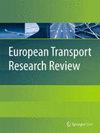利用计算实验探索电动和自主电动卡车的成本性能权衡和不确定性
IF 4.2
3区 工程技术
Q1 TRANSPORTATION
引用次数: 0
摘要
电池电动卡车(BETs)最近的发展表明,它们可以在向零排放道路货运过渡方面发挥重要作用。为了促进这一过渡,必须了解在哪些条件下电池电动卡车可以替代内燃机卡车(ICET)。与此同时,自动驾驶技术的发展为分析未来零排放卡车(如自动驾驶电动卡车(AET))的成本竞争力增加了不确定性和复杂性。本研究探讨了 BET 和 AET 与 ICET 相比的成本表现,以及在不同的市场和技术条件、充电策略和运输应用下的差异。研究重点是在瑞典运营满载穿梭运输的重型牵引拖车。由于所分析的因素之间存在固有的不确定性和相互作用,因此使用 BET、AET 和 ICET 穿梭车流运营及相关成本的仿真模型,以计算实验的形式进行分析。通过对模型中的 1200 个场景进行取样,共进行了 19200 次实验,这些场景代表了不同的运输应用和技术经济条件,涉及 16 种收费策略,包括车厂、目的地和途中收费的不同组合。结果表明,在大部分情况下,BET 和 AET 与 ICET 相比都具有成本竞争力。高资产利用率对于抵消车辆和充电器的额外投资成本非常重要,这凸显了在能够实现高生产率的应用中部署这些车辆的重要性。BET 的成本表现主要受能源相关成本、充电策略和充电基础设施利用率的影响。此外,自动驾驶汽车的成本性能还受到远程运营成本和自动驾驶系统成本的严重影响。在许多情况下,如果可行,仅依靠车厂充电是最具成本效益的充电策略,但长距离和重型货物的高能耗情况除外,在这些情况下,如果不辅以目的地或途中充电,所需的电池太重,卡车无法在车辆重量规定范围内运行。然而,许多实验并没有导致 BET 和 AET 的有效载荷能力低于 ICET,而且所考虑的绝大多数情况下,在现行车辆总重规定范围内使用 BET 或 AET 是可行的。本文章由计算机程序翻译,如有差异,请以英文原文为准。
Exploring cost performance tradeoffs and uncertainties for electric- and autonomous electric trucks using computational experiments
The recent development of battery electric trucks (BETs) suggests that they could play a vital role in transitioning to zero-emission road freight. To facilitate this transition, it is important to understand under which conditions BETs can be a viable alternative to internal combustion engine trucks (ICETs). Concurrently, the advancement of autonomous driving technology adds uncertainty and complexity to analyzing how the cost competitiveness of future zero-emissions trucks, such as autonomous electric trucks (AETs) may develop. This study examines the cost performance of BETs and AETs compared to ICETs, and how it varies over different market and technology conditions, charging strategies, and transport applications. Focus is on heavy-duty tractor-trailer trucks operating full truckload shuttle-flows in Sweden. Due to the inherent uncertainty and interactions among the analyzed factors, the analysis is performed as computational experiments using a simulation model of BET, AET, and ICET shuttle flow operations and associated costs. In total, 19,200 experiments are performed by sampling the model across 1200 scenarios representing various transport applications and technical and economic conditions for sixteen charging strategies with different combinations of depot, destination, and en route charging. The results indicate that both BETs and AETs are cost competitive compared to ICETs in a large share of scenarios. High asset utilization is important for offsetting additional investment costs in vehicles and chargers, highlighting the importance of deploying these vehicles in applications that enable high productivity. The cost performance for BETs is primarily influenced by energy related costs, charging strategy, and charging infrastructure utilization. The AET cost performance is in addition heavily affected by remote operations cost, and costs for the automated driving system. When feasible, relying only on depot charging is in many scenarios the most cost-effective charging strategy, with the primary exceptions being highly energy-demanding scenarios with long distances and heavy goods in which the required battery is too heavy to operate the truck within vehicle weight regulations if not complemented by destination, or en route charging. However, many experiments do not lead to a reduced payload capacity for BETs and AETs compared to ICETs, and a large majority of the considered scenarios are feasible to operate with a BET or AET within current gross vehicle weight regulations.
求助全文
通过发布文献求助,成功后即可免费获取论文全文。
去求助
来源期刊

European Transport Research Review
Engineering-Mechanical Engineering
CiteScore
8.60
自引率
4.70%
发文量
49
审稿时长
13 weeks
期刊介绍:
European Transport Research Review (ETRR) is a peer-reviewed open access journal publishing original high-quality scholarly research and developments in areas related to transportation science, technologies, policy and practice. Established in 2008 by the European Conference of Transport Research Institutes (ECTRI), the Journal provides researchers and practitioners around the world with an authoritative forum for the dissemination and critical discussion of new ideas and methodologies that originate in, or are of special interest to, the European transport research community. The journal is unique in its field, as it covers all modes of transport and addresses both the engineering and the social science perspective, offering a truly multidisciplinary platform for researchers, practitioners, engineers and policymakers. ETRR is aimed at a readership including researchers, practitioners in the design and operation of transportation systems, and policymakers at the international, national, regional and local levels.
 求助内容:
求助内容: 应助结果提醒方式:
应助结果提醒方式:


